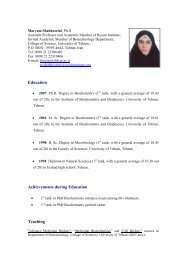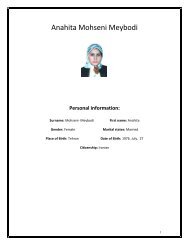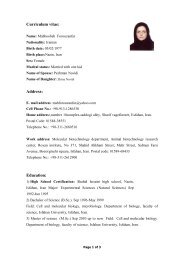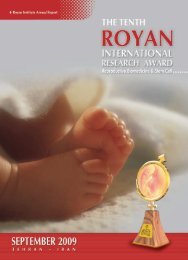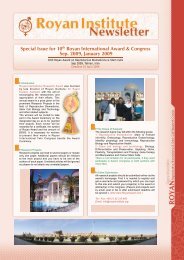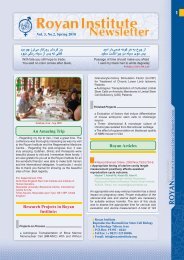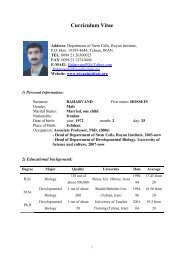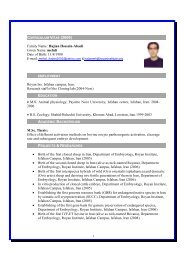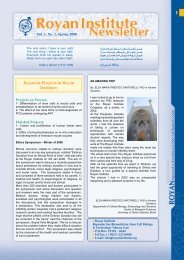Royan International Research Award - Royan Institute
Royan International Research Award - Royan Institute
Royan International Research Award - Royan Institute
- No tags were found...
Create successful ePaper yourself
Turn your PDF publications into a flip-book with our unique Google optimized e-Paper software.
The Eleventh ROYAN<strong>International</strong> <strong>Research</strong> <strong>Award</strong>KAZEMI PRIZEthe possibility of introducing mutations in predetermined genes via homologous recombination (for which Drs. Smithies and Cappechiwon the Nobel Prize), Dr. Jaenisch and colleagues genetically mutated the enzyme responsible for de novo DNA methylation anddemonstrated that DNA methylation is essential for the survival of somatic cells, for cancer development, genomic imprinting, Xchromosome inactivation and the stability of the genome.When the first cloned mammals produced by nuclear transplantation were published in 1997/1998, Dr. Jaenisch immediately recognizedthat nuclear cloning represents the most unbiased approach to study the role of epigenetics in development, differentiation and disease.He decided to refocus his research and used nuclear transplantation to study the mechanisms that cause reprogramming of the genome ofan adult cell to an embryonic state – producing a totipotent cell and, subsequently, an individual – from a lineage-specific adult cell.Somatic cell nuclear transfer (SCNT) and the derivation of “customized” ES cells opened the prospect of generating patient-specificES cells for stem cell therapy that would not be rejected after transplantation into the patient, a concept often referred to as “therapeuticcloning”. The Jaenisch laboratory was the first to demonstrate that SCNT in combination with gene therapy was a valid approach to treata genetic disorder of the immune system. While this “proof of principle” experiment was encouraging and suggested that this technologymight also work for stem cell therapy of human diseases, strong ethical objections were raised against the use of cloned human embryosfor the production of patient- specific ES cells. “Altered Nuclear Transfer” (ANT) was suggested as a potential solution to this dilemma.The ANT concept proposed to genetically alter the somatic donor cell prior to nuclear transfer into the egg with the goal that the productof this operation would not constitute a viable embryo, but would still be able to generate normal “customized” ES cells. Again, theJaenisch laboratory showed that the ANT approach would work and that normal ES cells can be generated from clones incapable ofimplantation and forming viable embryos.Although promising, the ethical barrier of using human eggs and low efficiency of generating “customized” ES cells via nuclear transferled Dr. Jaenisch to seek alternative ways to reprogram adult cells to a pluripotent ES cell-like state without the use of human eggs.Dr. Jaenisch and colleagues established the molecular circuitry of pluripotency, identified critical regulatory genes that distinguish theepigenetic state of an ES cell from that of a somatic cell, and discovered key transcription factors that provide the molecular identityand functionality of pluripotency. When expressed the key pluripotency factors in somatic cells, Yamanaka and colleague demonstratedin a landmark paper that four such factors were able to reprogram in vitro a skin cell to a pluripotent state. While the first publicationdid generate pluripotent cells, these cells were very different from normal ES cells by molecular and biological criteria, which causedwidespread skepticism as to the importance of this finding for medicine. It was only one year later when a crucial modification of theapproach both from the Jaenisch laboratory and the Yamanaka laboratory achieved the generation of pluripotent cells (iPS) that wereindistinguishable from normal ES cells by all criteria tested. These three publications reporting both similar and complementing resultsattracted enormous attention throughout the world and catapulted the induced pluripotent stem cell field to become one of the hottestareas in biology and medicine. More recently, his laboratory has made major inroads in understanding the mechanisms involved insomatic cell reprogramming. They showed that all somatic cells have the potential to generate iPS cells and that the process involvesstochastic events.Recent studies from the Jaenisch group have taken the promising reprogramming technology to stem cell therapy. At this level, I thinkthere is no question that the Jaenisch laboratory has lead the way in demonstrating, in mouse models, the practical potential for thistechnology, and suggested its way into the clinic. As a proof of principle study, the Jaenisch group recently demonstrated therapy for asickle cell anemia mouse model by utilizing iPS cells, derived from autologous skin cells, in which the mutated fetal hemoglobin genehad been repaired by homologous recombination. More recently, they demonstrated the integration of iPS derived neurons into fetalbrain and the subsequent reduction of symptoms in rats with Parkinson’s disease, again paving the road toward iPS-mediated therapy inhumans.To extended stem cell therapy to clinic, the Jaenisch group has generated a series of patient specific iPS cells from biopsies of patientswith the Parkinson’s disease. Importantly, the approach used led to iPS cells from which the reprogramming vectors had been removed.However, the translation of the iPS approach to stem cell therapy of human diseases still faces major technical issues. One importantunresolved problem has been the inefficiency of genetic manipulations in human ES or iPS cells, a procedure that is routine in mouseES cells. Recently, the Jaenisch group used a novel approach for gene targeting that involved Zn-finger nucleases that allowed efficientcorrect genetic alterations in human ES and iPS cells, paving the road for stem cell therapy of human diseases. A major set back for thehuman stem cell field has been that human ES cells are so difficult to work with: they do not grow as single cells, require mechanicalpassage and are inefficient in using homologous recombination for gene targeting. Most recently, the Jaenisch lab has generated newhuman ES cells that have properties of mouse ES cells, a breakthrough that may allow using similar methods with human cells as hasbeen routine with mouse.During the past forty years, Dr. Jaenisch has coauthored more than 400 research papers and has received numerous prizes and otherforms of recognition. He was elected to the National Academy of Sciences in 2003, and received the Peter Gruber Foundation <strong>Award</strong> inGenetics, the Robert Koch Prize for Excellence in Scientific Achievement, the Charles Rodolphe Brupracher Foundation Cancer <strong>Award</strong>,the Max Delbrück Medal for Molecular Medicine and the Vilcek Foundation Prize for Achievements of Prominent Immigrants – onlya few among the many honors and awards he has received. Throughout his scientific career, he has published more than 400 scientificpapers and has mentored more than 200 students and postdoctoral fellows, many of whom have become the leaders of their respectivefields. He has traveled around world and promotes international scientific exchange and collaborations. Dr. Jaenisch is one of the mostinnovative and creative scientists in the field of developmental biology, gene regulation, stem cell biology and stem cell-mediatedtherapies.49



